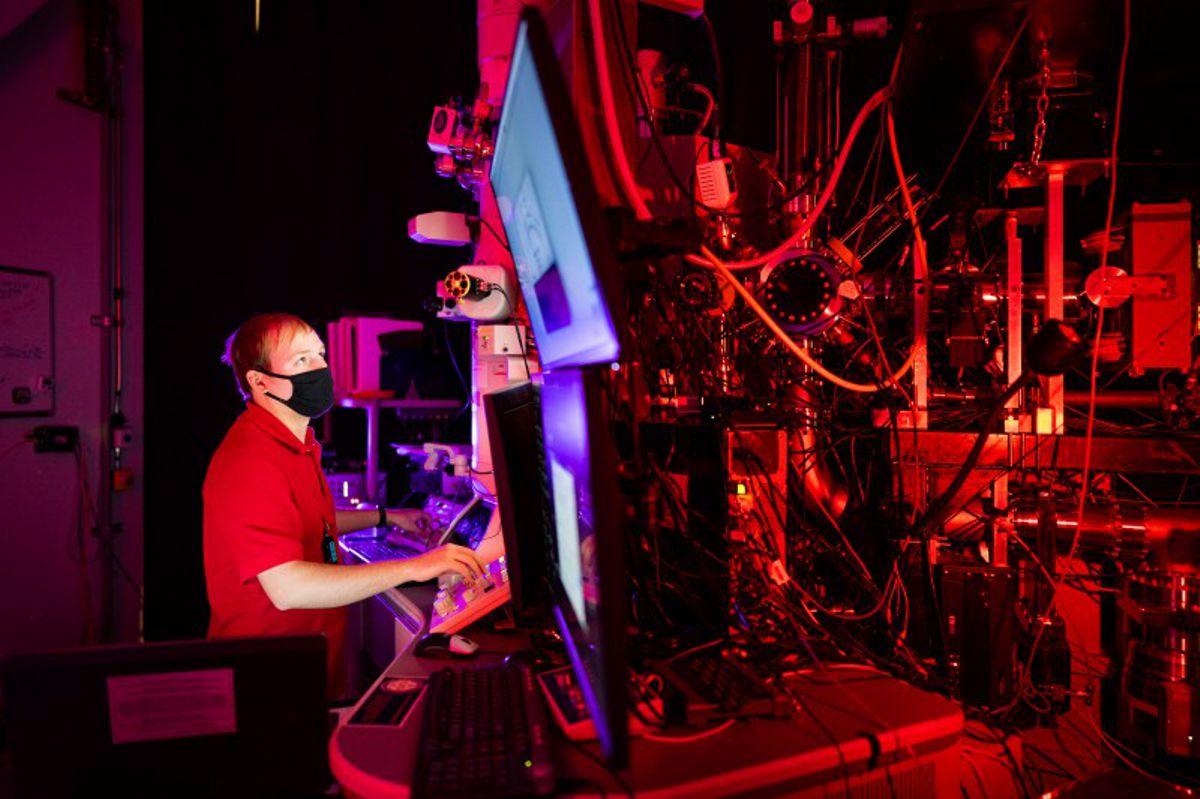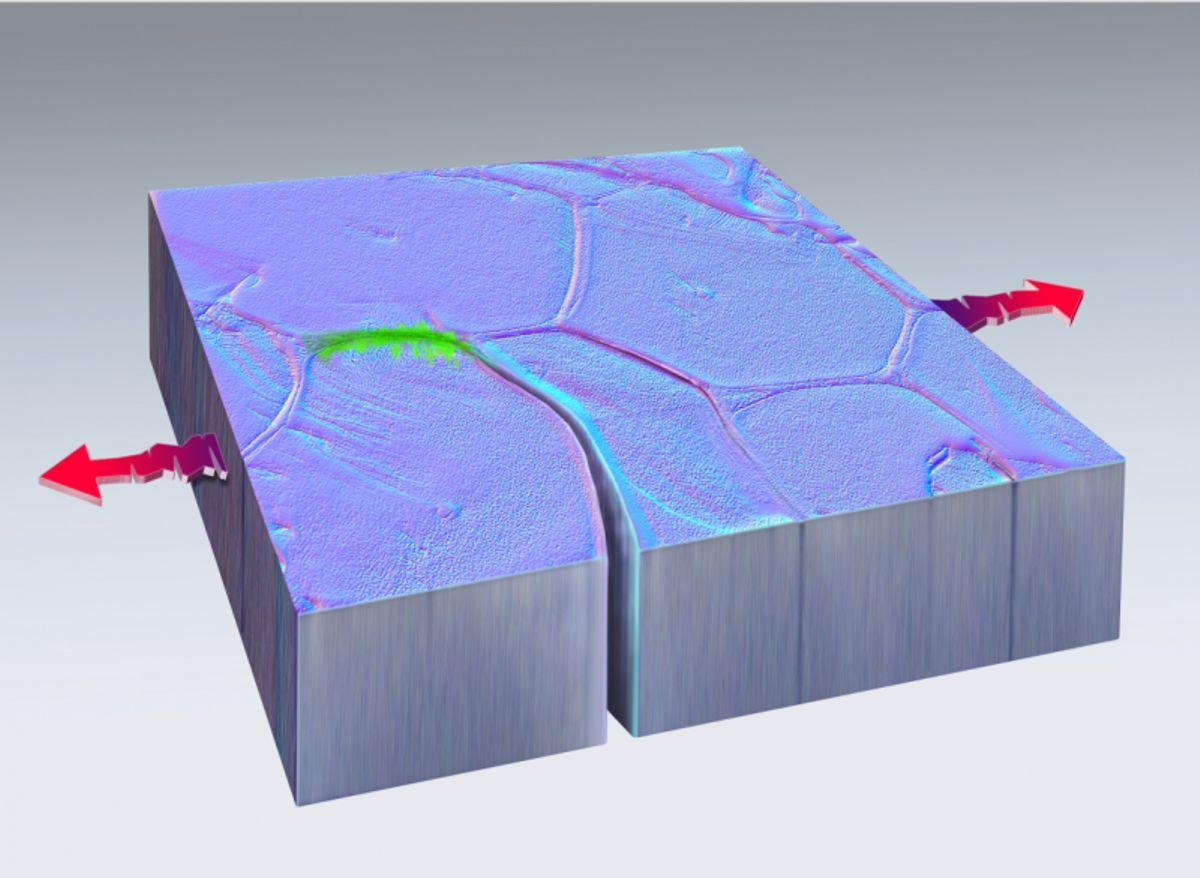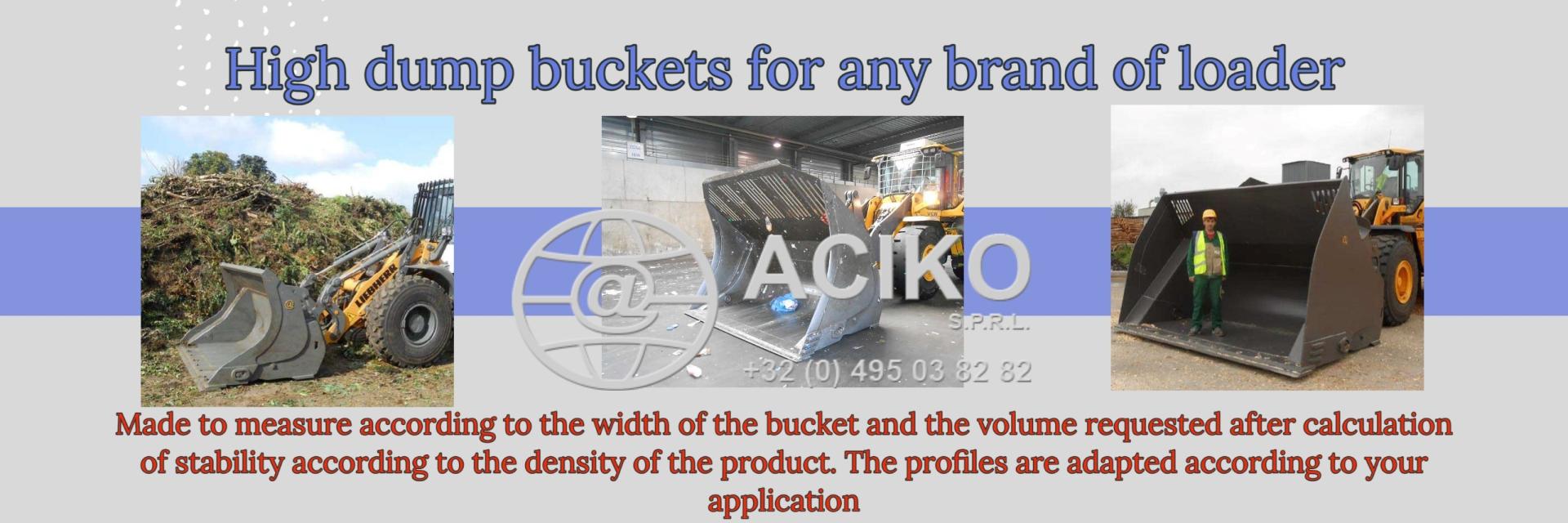Scientists discover that Metals can heal themselves
 24/07/23-FR-English-NL-footer
24/07/23-FR-English-NL-footer
Les scientifiques découvrent que les métaux peuvent se guérir eux-mêmes
 Sandia National Laboratories researcher Ryan Schoell uses a specialized transmission electron microscope technique developed by Khalid Hattar, Dan Bufford and Chris Barr to study fatigue cracks at the nanoscale. Credit: Craig Fritz, Sandia National Laboratories.
Sandia National Laboratories researcher Ryan Schoell uses a specialized transmission electron microscope technique developed by Khalid Hattar, Dan Bufford and Chris Barr to study fatigue cracks at the nanoscale. Credit: Craig Fritz, Sandia National Laboratories.
 Green marks the spot where a fissure formed, then fused back together in this artistic rendering of nanoscale self-healing in metal, discovered at Sandia National Laboratories. Red arrows indicate the direction of the pulling force that unexpectedly triggered the phenomenon. Credit: Dan Thompson, Sandia National Laboratories.
Green marks the spot where a fissure formed, then fused back together in this artistic rendering of nanoscale self-healing in metal, discovered at Sandia National Laboratories. Red arrows indicate the direction of the pulling force that unexpectedly triggered the phenomenon. Credit: Dan Thompson, Sandia National Laboratories.
Les scientifiques ont pour la première fois vu des morceaux de métal se fissurer, puis fusionner sans aucune intervention humaine, renversant ainsi les théories scientifiques fondamentales. Si le phénomène nouvellement découvert peut être exploité, il pourrait inaugurer une révolution technique - une révolution dans laquelle les moteurs, les ponts et les avions auto-cicatrisants pourraient inverser les dommages causés par l'usure, les rendant plus sûrs et plus durables.
"C'était absolument époustouflant à regarder de première main", a déclaré Brad Boyce, scientifique des matériaux chez Sandia.
"Ce que nous avons confirmé, c'est que les métaux ont leur propre capacité intrinsèque et naturelle à se guérir, du moins dans le cas de dommages par fatigue à l'échelle nanométrique", a déclaré Boyce.
Les dommages causés par la fatigue sont l'une des façons dont les machines s'usent et finissent par se casser. Des contraintes ou des mouvements répétés provoquent la formation de fissures microscopiques. Au fil du temps, ces fissures se développent et se propagent jusqu'à ce que - snap ! L'ensemble de l'appareil se casse, ou dans le jargon scientifique, il échoue.
La fissure que Boyce et son équipe ont vue disparaître était l'une de ces fractures minuscules mais conséquentes - mesurées en nanomètres.
"Des joints de soudure dans nos appareils électroniques aux moteurs de nos véhicules en passant par les ponts sur lesquels nous roulons, ces structures échouent souvent de manière imprévisible en raison d'une charge cyclique qui conduit à l'initiation de fissures et à une éventuelle fracture", a déclaré Boyce. « Lorsqu'ils tombent en panne, nous devons faire face à des coûts de remplacement, à des pertes de temps et, dans certains cas, à des blessures ou à des pertes de vie. L'impact économique de ces échecs se mesure en centaines de milliards de dollars chaque année pour les États-Unis.
Bien que les scientifiques aient créé des matériaux auto-cicatrisants, principalement des plastiques, la notion de métal auto-cicatrisant a largement été du domaine de la science-fiction.
« Les fissures dans les métaux devaient toujours grossir, pas plus petites. Même certaines des équations de base que nous utilisons pour décrire la croissance des fissures excluent la possibilité de tels processus de guérison », a déclaré Boyce.
Dan Thompson, Sandia National Laboratories Le vert marque l'endroit où une fissure s'est formée, puis fusionnée dans ce rendu artistique de l'auto-guérison à l'échelle nanométrique dans le métal, découvert aux Sandia National Laboratories. Les flèches rouges indiquent la direction de la force de traction qui a déclenché de manière inattendue le phénomène.
Le vert marque l'endroit où une fissure s'est formée, puis fusionnée dans ce rendu artistique de l'auto-guérison à l'échelle nanométrique dans le métal, découvert aux laboratoires nationaux de Sandia. Les flèches rouges indiquent la direction de la force de traction qui a déclenché de manière inattendue le phénomène.
En 2013, Michael Demkowicz - alors professeur adjoint au département de science et d'ingénierie des matériaux du Massachusetts Institute of Technology, maintenant professeur titulaire à Texas A&M - a commencé à s'attaquer à la théorie des matériaux conventionnels. Il a publié une nouvelle théorie, basée sur les résultats de simulations informatiques, selon laquelle, dans certaines conditions, le métal devrait être capable de souder des fissures fermées formées par l'usure.
La découverte que sa théorie était vraie est venue par inadvertance au Center for Integrated Nanotechnologies, une installation utilisateur du Département de l'énergie exploitée conjointement par les laboratoires nationaux Sandia et Los Alamos.
"Nous ne le cherchions certainement pas", a déclaré Boyce.
Khalid Hattar, maintenant professeur agrégé à l'Université du Tennessee à Knoxville, et Chris Barr, qui travaille maintenant pour le Bureau de l'énergie nucléaire du Département de l'énergie, dirigeaient l'expérience à Sandia lorsque la découverte a été faite. Ils voulaient seulement évaluer comment les fissures se formaient et se propageaient à travers un morceau de platine à l'échelle nanométrique en utilisant une technique de microscope électronique spécialisée qu'ils avaient développée pour tirer à plusieurs reprises sur les extrémités du métal 200 fois par seconde.
Étonnamment, environ 40 minutes après le début de l'expérience, les dégâts se sont inversés. Une extrémité de la fissure a fusionné comme si elle revenait sur ses pas, ne laissant aucune trace de l'ancienne blessure. Au fil du temps, la fissure s'est régénérée dans une direction différente.
Boyce, qui était au courant de la théorie, a partagé ses découvertes avec Demkowicz.
"J'étais très heureux de l'entendre, bien sûr", a déclaré Demkowicz. Le professeur a ensuite recréé l'expérience sur un modèle informatique, prouvant que le phénomène observé à Sandia était le même qu'il avait théorisé des années plus tôt.
Leur travail a été soutenu par le Bureau des sciences du Département de l'énergie, Sciences énergétiques fondamentales; la National Nuclear Security Administration et la National Science Foundation.
Beaucoup reste inconnu sur le processus d'auto-guérison, y compris s'il deviendra un outil pratique dans un environnement de fabrication.
"La mesure dans laquelle ces résultats sont généralisables fera probablement l'objet de recherches approfondies", a déclaré Boyce. «Nous montrons que cela se produit dans les métaux nanocristallins sous vide. Mais nous ne savons pas si cela peut également être induit dans les métaux conventionnels dans l'air.
Pourtant, malgré toutes les inconnues, la découverte reste un bond en avant à la frontière de la science des matériaux.
"J'espère que cette découverte encouragera les chercheurs en matériaux à considérer que, dans les bonnes circonstances, les matériaux peuvent faire des choses auxquelles nous ne nous attendions pas", a déclaré Demkowicz.
Sandia National Laboratories est un laboratoire multi-missions exploité par National Technology and Engineering Solutions de Sandia LLC, une filiale en propriété exclusive de Honeywell International Inc., pour la National Nuclear Security Administration du Département américain de l'énergie. Sandia Labs a d'importantes responsabilités de recherche et développement dans les domaines de la dissuasion nucléaire, de la sécurité mondiale, de la défense, des technologies énergétiques et de la compétitivité économique, avec des installations principales à Albuquerque, au Nouveau-Mexique, et à Livermore, en Californie.
NJC.© Info Sandia National Laboratories
-------------------------------------------------------------------------------------------------------------------
 24/07/23-English
24/07/23-English
Scientists discover that Metals can heal themselves
 Sandia National Laboratories researcher Ryan Schoell uses a specialized transmission electron microscope technique developed by Khalid Hattar, Dan Bufford and Chris Barr to study fatigue cracks at the nanoscale. Credit: Craig Fritz, Sandia National Laboratories.
Sandia National Laboratories researcher Ryan Schoell uses a specialized transmission electron microscope technique developed by Khalid Hattar, Dan Bufford and Chris Barr to study fatigue cracks at the nanoscale. Credit: Craig Fritz, Sandia National Laboratories.
 Green marks the spot where a fissure formed, then fused back together in this artistic rendering of nanoscale self-healing in metal, discovered at Sandia National Laboratories. Red arrows indicate the direction of the pulling force that unexpectedly triggered the phenomenon. Credit: Dan Thompson, Sandia National Laboratories.
Green marks the spot where a fissure formed, then fused back together in this artistic rendering of nanoscale self-healing in metal, discovered at Sandia National Laboratories. Red arrows indicate the direction of the pulling force that unexpectedly triggered the phenomenon. Credit: Dan Thompson, Sandia National Laboratories.
Scientists for the first time have witnessed pieces of metal crack, then fuse back together without any human intervention, overturning fundamental scientific theories in the process. If the newly discovered phenomenon can be harnessed, it could usher in an engineering revolution — one in which self-healing engines, bridges and airplanes could reverse damage caused by wear and tear, making them safer and longer-lasting.
“This was absolutely stunning to watch first-hand,” said Sandia materials scientist Brad Boyce.
“What we have confirmed is that metals have their own intrinsic, natural ability to heal themselves, at least in the case of fatigue damage at the nanoscale,” Boyce said.
Fatigue damage is one way machines wear out and eventually break. Repeated stress or motion causes microscopic cracks to form. Over time, these cracks grow and spread until — snap! The whole device breaks, or in the scientific lingo, it fails.
The fissure Boyce and his team saw disappear was one of these tiny but consequential fractures — measured in nanometres.
“From solder joints in our electronic devices to our vehicle’s engines to the bridges that we drive over, these structures often fail unpredictably due to cyclic loading that leads to crack initiation and eventual fracture,” Boyce said. “When they do fail, we have to contend with replacement costs, lost time and, in some cases, even injuries or loss of life. The economic impact of these failures is measured in hundreds of billions of dollars every year for the U.S.”
Although scientists have created some self-healing materials, mostly plastics, the notion of a self-healing metal has largely been the domain of science fiction.
“Cracks in metals were only ever expected to get bigger, not smaller. Even some of the basic equations we use to describe crack growth preclude the possibility of such healing processes,” Boyce said.
Dan Thompson, Sandia National Laboratories Green marks the spot where a fissure formed, then fused back together in this artistic rendering of nanoscale self-healing in metal, discovered at Sandia National Laboratories. Red arrows indicate the direction of the pulling force that unexpectedly triggered the phenomenon.
Green marks the spot where a fissure formed, then fused back together in this artistic rendering of nanoscale self-healing in metal, discovered at Sandia National Laboratories. Red arrows indicate the direction of the pulling force that unexpectedly triggered the phenomenon.
In 2013, Michael Demkowicz — then an assistant professor at the Massachusetts Institute of Technology’s department of materials science and engineering, now a full professor at Texas A&M — began chipping away at conventional materials theory. He published a new theory, based on findings in computer simulations, that under certain conditions metal should be able to weld shut cracks formed by wear and tear.
The discovery that his theory was true came inadvertently at the Center for Integrated Nanotechnologies, a Department of Energy user facility jointly operated by Sandia and Los Alamos national laboratories.
“We certainly weren’t looking for it,” Boyce said.
Khalid Hattar, now an associate professor at the University of Tennessee, Knoxville, and Chris Barr, who now works for the Department of Energy’s Office of Nuclear Energy, were running the experiment at Sandia when the discovery was made. They only meant to evaluate how cracks formed and spread through a nanoscale piece of platinum using a specialized electron microscope technique they had developed to repeatedly pull on the ends of the metal 200 times per second.
Surprisingly, about 40 minutes into the experiment, the damage reversed course. One end of the crack fused back together as if it was retracing its steps, leaving no trace of the former injury. Over time, the crack regrew along a different direction.
Boyce, who was aware of the theory, shared his findings with Demkowicz.
“I was very glad to hear it, of course,” Demkowicz said. The professor then recreated the experiment on a computer model, substantiating that the phenomenon witnessed at Sandia was the same one he had theorized years earlier.
Their work was supported by the Department of Energy’s Office of Science, Basic Energy Sciences; the National Nuclear Security Administration and the National Science Foundation.
A lot remains unknown about the self-healing process, including whether it will become a practical tool in a manufacturing setting.
“The extent to which these findings are generalizable will likely become a subject of extensive research,” Boyce said. “We show this happening in nanocrystalline metals in vacuum. But we don’t know if this can also be induced in conventional metals in air.”
Yet for all the unknowns, the discovery remains a leap forward at the frontier of materials science.
“My hope is that this finding will encourage materials researchers to consider that, under the right circumstances, materials can do things we never expected,” Demkowicz said.
Sandia National Laboratories is a multi-mission laboratory operated by National Technology and Engineering Solutions of Sandia LLC, a wholly owned subsidiary of Honeywell International Inc., for the U.S. Department of Energy’s National Nuclear Security Administration. Sandia Labs has major research and development responsibilities in nuclear deterrence, global security, defence, energy technologies and economic competitiveness, with main facilities in Albuquerque, New Mexico, and Livermore, California.
NJC.© Info Sandia National Laboratories
-------------------------------------------------------------------------------------------------------------------
 24/07/23-NL
24/07/23-NL
Wetenschappers ontdekken dat metalen zichzelf kunnen genezen
 Sandia National Laboratories researcher Ryan Schoell uses a specialized transmission electron microscope technique developed by Khalid Hattar, Dan Bufford and Chris Barr to study fatigue cracks at the nanoscale. Credit: Craig Fritz, Sandia National Laboratories.
Sandia National Laboratories researcher Ryan Schoell uses a specialized transmission electron microscope technique developed by Khalid Hattar, Dan Bufford and Chris Barr to study fatigue cracks at the nanoscale. Credit: Craig Fritz, Sandia National Laboratories.
 Green marks the spot where a fissure formed, then fused back together in this artistic rendering of nanoscale self-healing in metal, discovered at Sandia National Laboratories. Red arrows indicate the direction of the pulling force that unexpectedly triggered the phenomenon. Credit: Dan Thompson, Sandia National Laboratories.
Green marks the spot where a fissure formed, then fused back together in this artistic rendering of nanoscale self-healing in metal, discovered at Sandia National Laboratories. Red arrows indicate the direction of the pulling force that unexpectedly triggered the phenomenon. Credit: Dan Thompson, Sandia National Laboratories.
Wetenschappers zijn voor het eerst getuige geweest van stukjes metaal die barsten en vervolgens weer samensmelten zonder enige menselijke tussenkomst, waarbij fundamentele wetenschappelijke theorieën in het proces werden omvergeworpen. Als het nieuw ontdekte fenomeen kan worden benut, kan dit een technische revolutie inluiden - een waarin zelfherstellende motoren, bruggen en vliegtuigen schade veroorzaakt door slijtage kunnen ongedaan maken, waardoor ze veiliger en duurzamer worden.
"Dit was absoluut verbluffend om uit de eerste hand te zien", zegt materiaalwetenschapper Brad Boyce van Sandia.
"Wat we hebben bevestigd, is dat metalen hun eigen intrinsieke, natuurlijke vermogen hebben om zichzelf te genezen, althans in het geval van vermoeidheidsschade op nanoschaal," zei Boyce.
Vermoeiingsschade is een manier waarop machines verslijten en uiteindelijk kapot gaan. Herhaalde spanning of beweging veroorzaakt microscopische scheurtjes. In de loop van de tijd groeien en verspreiden deze scheuren zich totdat - snap! Het hele apparaat breekt, of in de wetenschappelijke taal, het faalt.
De spleet die Boyce en zijn team zagen verdwijnen, was een van deze kleine maar consequente breuken - gemeten in nanometers.
"Van soldeerverbindingen in onze elektronische apparaten tot de motoren van onze voertuigen tot de bruggen waar we overheen rijden, deze structuren falen vaak op onvoorspelbare wijze als gevolg van cyclische belasting die leidt tot scheurinitiatie en uiteindelijke breuk," zei Boyce. “Als ze toch falen, hebben we te kampen met vervangingskosten, verloren tijd en in sommige gevallen zelfs met verwondingen of het verlies van mensenlevens. De economische impact van deze mislukkingen wordt elk jaar gemeten in honderden miljarden dollars voor de VS.”
Hoewel wetenschappers een aantal zelfherstellende materialen hebben gemaakt, voornamelijk kunststoffen, is het idee van een zelfherstellend metaal grotendeels het domein van sciencefiction geweest.
“Van scheuren in metalen werd nooit verwacht dat ze groter zouden worden, niet kleiner. Zelfs enkele van de basisvergelijkingen die we gebruiken om de groei van scheuren te beschrijven, sluiten de mogelijkheid van dergelijke genezingsprocessen uit,' zei Boyce.
Dan Thompson, Sandia National Laboratories Groen markeert de plek waar een spleet ontstond en vervolgens weer samensmolt in deze artistieke weergave van zelfherstel op nanoschaal in metaal, ontdekt bij Sandia National Laboratories. Rode pijlen geven de richting aan van de trekkracht die het fenomeen onverwacht veroorzaakte.
Groen markeert de plek waar zich een spleet heeft gevormd en vervolgens weer is samengesmolten in deze artistieke weergave van zelfherstel op nanoschaal in metaal, ontdekt in Sandia National Laboratories. Rode pijlen geven de richting aan van de trekkracht die het fenomeen onverwacht veroorzaakte.
In 2013 begon Michael Demkowicz - toen assistent-professor aan de afdeling materiaalkunde en engineering van het Massachusetts Institute of Technology, nu hoogleraar aan Texas A&M - de conventionele materiaaltheorie weg te werken. Hij publiceerde een nieuwe theorie, gebaseerd op bevindingen in computersimulaties, dat metaal onder bepaalde omstandigheden in staat zou moeten zijn om door slijtage veroorzaakte scheuren dicht te lassen.
De ontdekking dat zijn theorie waar was, kwam onbedoeld bij het Center for Integrated Nanotechnologies, een gebruikersfaciliteit van het Department of Energy die gezamenlijk wordt beheerd door de nationale laboratoria van Sandia en Los Alamos.
"We waren er zeker niet naar op zoek", zei Boyce.
Khalid Hattar, nu universitair hoofddocent aan de Universiteit van Tennessee, Knoxville, en Chris Barr, die nu werkt voor het Office of Nuclear Energy van het Department of Energy, voerden het experiment uit in Sandia toen de ontdekking werd gedaan. Ze wilden alleen evalueren hoe scheuren zich vormden en verspreidden door een stuk platina op nanoschaal met behulp van een gespecialiseerde elektronenmicroscooptechniek die ze hadden ontwikkeld om herhaaldelijk 200 keer per seconde aan de uiteinden van het metaal te trekken.
Verrassend genoeg keerde de schade na ongeveer 40 minuten van het experiment om. Het ene uiteinde van de scheur smolt weer samen alsof het op zijn schreden terugkeerde en liet geen spoor achter van de eerdere verwonding. Na verloop van tijd groeide de scheur in een andere richting terug.
Boyce, die op de hoogte was van de theorie, deelde zijn bevindingen met Demkowicz.
"Ik was natuurlijk erg blij om het te horen", zei Demkowicz. De professor reconstrueerde het experiment vervolgens op een computermodel, waarbij hij aantoonde dat het waargenomen fenomeen bij Sandia hetzelfde was als hij jaren eerder had getheoretiseerd.
Hun werk werd ondersteund door het Office of Science van het Department of Energy, Basic Energy Sciences; de National Nuclear Security Administration en de National Science Foundation.
Er is nog veel onbekend over het zelfherstellende proces, ook of het een praktisch hulpmiddel zal worden in een productieomgeving.
"De mate waarin deze bevindingen generaliseerbaar zijn, zal waarschijnlijk een onderwerp van uitgebreid onderzoek worden", zei Boyce. “We laten zien dat dit gebeurt in nanokristallijne metalen in vacuüm. Maar we weten niet of dit ook kan worden geïnduceerd in conventionele metalen in lucht.”
Maar voor alle onbekenden blijft de ontdekking een sprong voorwaarts op de grens van de materiaalwetenschap.
"Ik hoop dat deze bevinding materiaalonderzoekers zal aanmoedigen om te overwegen dat materialen, onder de juiste omstandigheden, dingen kunnen doen die we nooit hadden verwacht", zei Demkowicz.
Sandia National Laboratories is een laboratorium met meerdere missies dat wordt beheerd door National Technology and Engineering Solutions van Sandia LLC, een volledige dochteronderneming van Honeywell International Inc., voor de National Nuclear Security Administration van het Amerikaanse ministerie van Energie. Sandia Labs heeft grote onderzoeks- en ontwikkelingsverantwoordelijkheden op het gebied van nucleaire afschrikking, wereldwijde veiligheid, defensie, energietechnologieën en economisch concurrentievermogen, met hoofdfaciliteiten in Albuquerque, New Mexico, en Livermore, Californië.
NJC.© Info Sandia National Laboratories
--------------------------------------------------------------------------------------------------------------
Date de dernière mise à jour : 20/07/2023
















